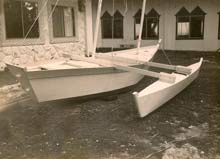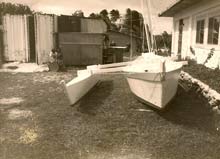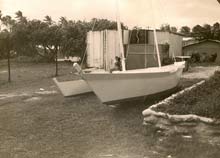Kejak is the Marshallese word for funny. Actually the building of Kejak, a 21 foot dory sail boat was a funny thing. We had built our house out of cement and had used a lot of wood for the cement forms. Even the ceiling was cement, and we had used wood braces underneath. We used some in the interior of the house, sold a few pieces to other people, but most of the wood was sitting on the roof of our house quietly rotting.
 |
Kejak is the Marshallese word for funny. Actually the building of Kejak, a 21 foot dory sail boat was a funny thing. |
The idea came from the nautical book, Mother Earth News, to build Kejak. Actually it isn’t a boating book, but they had an article of someone
building a sailing dory. I started in, with
building a cardboard model to see if the way the sides were flared could be modified. When that was determined, the next thing was to re-figure sail area and centerboard/rudder configurations.
I switched from a sloop to a stay sail schooner rig, and from a keel boat, to centerboard.
We knew from the beginning that we were looking at a cheap way to make a boat. An engine would more than triple my expenses on Kejak as we made it in the water for less than $300. (1980s) The cleats were rough cut from pine 2x4’s, the sails were homemade( my first). The masts were 2x4’s stayed with rope. Very bendy, but at least we put the small end of the 2x4 frontwards to help us out aerodynamically. The oars were made from 2x2’s. the boat was 21 feet long counting the rudder. The bottom was only four feet wide because that was the width of the plywood sheet.
The deck from gunwale to gunwale was about 4-½ feet wide at the top because of the flare. The sides were only two feet high because that is the width you get when ripping a 4x8 sheet of ply; unless of course you turn it the other way, but a boat with four foot sides is generally much bigger than Kejak was going to be. Anything less than two feet would mean that it would take at least two cuts on the plywood to get the proper size, taking longer to build, which we also wanted to avoid.
One 2x6 on the gunwale was added for looks.
| The deck from gunwale to gunwale was about 4-½ feet wide at the top because of the flare. The sides were only two feet high because that is the width you get when ripping a 4x8 sheet of ply. |
 |
At first I wanted to make it as much my own project as possible and had every intention of doing so. However, one man in our church unexpectedly lost his job, evidently because he was in the wrong political party, and I hired him about half way through.
The centerboard/rudder size were finally determined by the amount of spare wood I had laying around the yard, not by my set of plans, or theirs, much to my regret later.
Even though the stores did not carry sail hanks, they did carry sail material, and I bought some and dug out a book on making your own sails.
Making the sails here proved to be an experience.
The book says that you should use a soldering iron to cut the material to keep it from unraveling. I had the soldering iron, a place to plug it into, but we were in the middle of power outages most of the time. Parts of Kejak were made between midnight and six am, because that is when we had electrical power. To get the soldering iron hot, I heated the top with a torch, and then cut an inch or two before it got too cold. The Bible says that tribulation worketh patience.
Initially we tied the sails on the stays. We were fortunately never in a hurry getting sails down.
When the big launch day came I was all set. I asked my helper if everything was OK for a launch. It turns out that you should have a party for a launch (Marshallese custom). So we weren’t ready.
We ordered a cake and planned on a launching party on Saturday. We made no big thing of it, however, we did go around and tell one man, Leonard DeBrum, and all the people in the church. While I do give credit to the fact that Leonard had the most notice, everybody else showed up for the cake and to help. Mr. DeBrum showed with a piece of cloth to drape over the boat, Marshallese custom.
Everyone enjoyed the cake and kool aid, and joked about the unveiling of the name. Then it was time to put the boat to the test, and admittedly I was being tested too.
We took the wood cover off the bed of our truck, and loaded Kejak on, sideways! We were 20 feet wide going down the road. Naturally it attracted plenty of attention.
The launch site was close by. Living on an island that is at best half mile wide, a launch site was always close at hand. But this one actually had a concrete ramp. With many helping hands, Kejak was in the water with no problem. I got in and had the sails up, but encountered some problems when I told the boys going with me to jump on board. That is what they did. They about swamped the boat in front of all the spectators.
The question of whether I would need weight for ballast was answered right there. Definitely we were in the need for more ballast.
The hold on the shore was turned loose before I was ready, and I realized that we were underway, with no steerage. A quick look around made me realize that there was no sense in getting flustered , and just laugh when everybody else did, as we simply rammed a boat floating nearby.
The laughter from the crowd insured the name Kejak was proper!
Once sailing we encountered some difficult problems. The wind was gusty that day and without ballast, we would balance ourselves for the wind. Then it would quit, it would almost throw us off into the water. By jumping to the other side we were then at the mercy of the next strong gust. Twenty one feet is a big dinghy to sail. It was also a tiring boat to sail.
Trying to go back to the launching area to pick up some new passengers, I found out that we simply couldn’t. Hard on the wind we were going sideways through the water. My modified plans for the centerboard and rudder were too modified.
Each time we tacked to make the launch area we got farther from the shore.
A decision was made that since we could not get back to where we wanted to, then at least we were going to try for the other side of the lagoon where the anchor site was located. The other choice was to go down wind and end up on the far side of the lagoon in Laura, about 30 miles away.
Somehow, just before dark, we got into shore near Kirk Pinto’s yacht basin. I took the taxi home, and got the big anchor and returned to anchor Kejak for the weekend.
On Monday we practiced sailing her inside the basin to check out how she sailed. To be on the safe side of that, we kept her tied to the anchor located up on the beach. Finally convinced that she would now behave, we planned the next move for Tuesday, to her permanent anchor site.
To ever have any rest on board Kejak we were going to have to do something about her unstable nature. After checking around, I found a 4’x8’x1/4” piece of steel being thrown away at the junkyard. It was bent in two, but I figured that was the least of my worries. After trying to pick it up with 5, or 6 guys we went and got a fork lift. I traded it for some steel a little thinner, and cut to shape so that Kejak had a new centerboard. Installing it was going to be much more of a problem than I anticipated.
We decided to top load it through the centerboard lot on a sandy beach near the anchor site. We brought her up to the beach and carried the centerboard to the boat. It jammed going in, as we were drifting out. The Marshallese were unconcerned but I dropped the anchor before going too far; after all a visit to Laura was still a possibility.
Getting it unstuck was something else. Three of us had trouble getting it out. We took it back up the beach and tried to get it straight by pounding on it with a small hammer. Naturally it jammed going back in. By this time the sun had done me in, and it was all I could do to stand up. I left the two young men that were with me, and went to get re-enforcement. With new help.
And a sledge hammer, we got the centerboard straight. Justin Peter got the idea to turn the boat on its side and push it from the bottom. We beat on it till it worked. We launched it on a short sail. A brief burst of wind and rain proved Kejak was going to behave with a steel centerboard.
 |
By this time the sun had done me in, and it was all I could do to stand up. I left the two young men that were with me, and went to get re-enforcement. |
We have since been all over the lagoon with Kejak and she has proven that she can carry a load and sail well. We’ve had ten guys on board plus a couple of bags of coconuts. She has also withstood some horrendous weather while at anchor that put two yachts on the beach. While she does well, the thought I kept running through my mind that getting rid of that steel centerboard and putting training wheels on the side would make it go faster!
So I went back and cut a 2x4 with a sharp angle on it and tapered it front to back with the front wide enough for a 2x2 to mate up with it. I now had the keel and the bow/stern. I ripped a 1/4"
ply two foot wide, nailed it on the keel and bow/stern (This thing could go either way), jam
in some bulkheads. Attach a 2x4 for a crossbeam
between the main hull at a bulkhead, and this new outrigger bulkhead. I was now looking at a Pacific/Atlantic Proa.
The name of this new addition to Kejak? I called the outrigger Kajererre (Marshallese word for “to make fun of”).
I could never tell if the new boat preformed
better than the old. Seemed much the same. But
it was much lighter to pick up when necessary. I had a wooden center board I could raise and lower. I had an extra hull for gear storage.
For dollars spent, hours worked, this has been one of my most successful fun boats I have ever owned. We have gone sailing just to watch a mooner eclipse from the lagoon, spent all night out sailing on several occasions. We have hauled people and gear for a weekend outing on a deserted island.
***** |

